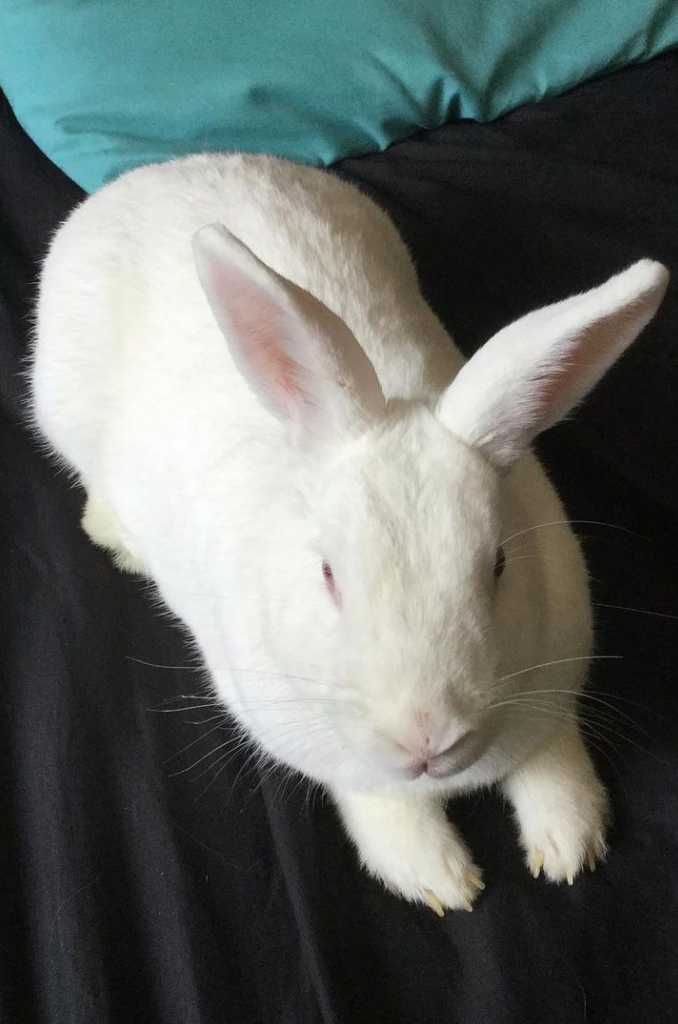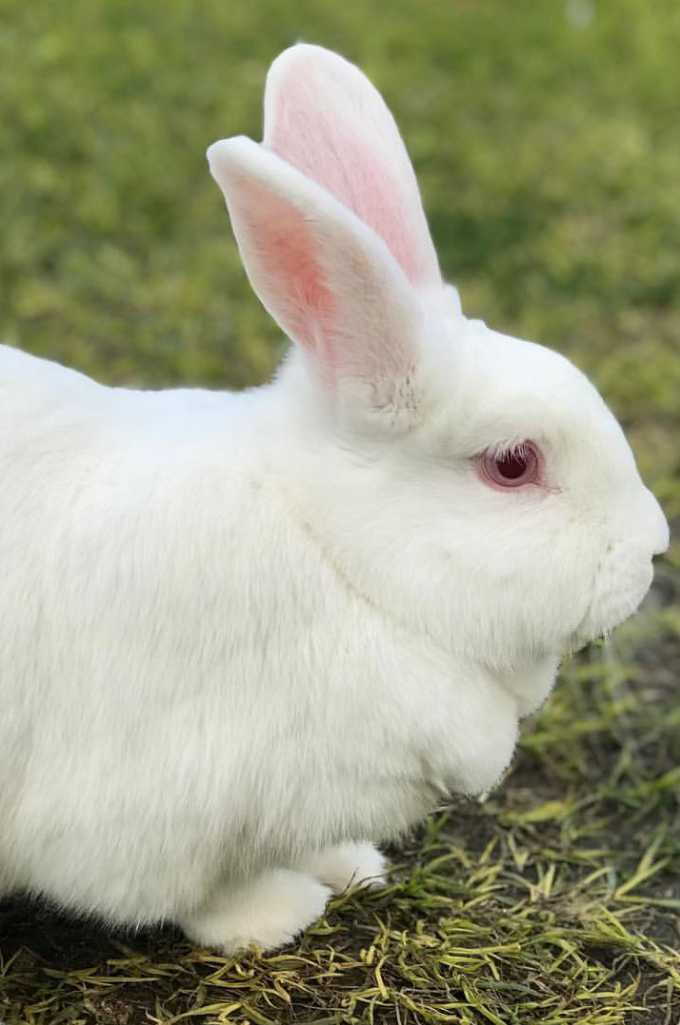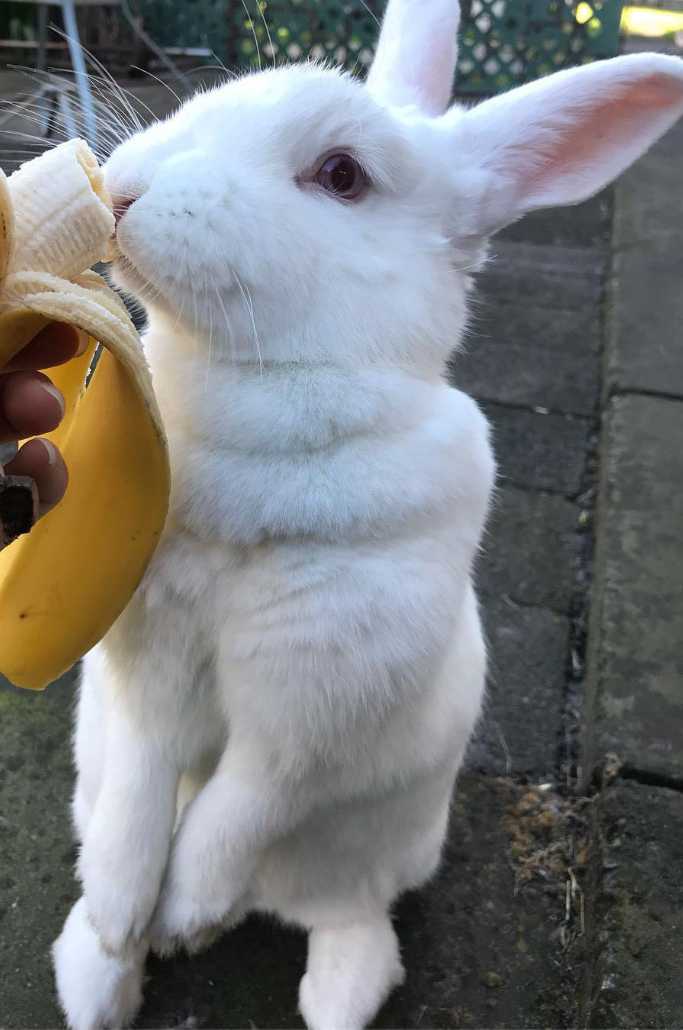White is one of, if not the most popular rabbit color out there. All rabbits are adorable, but the white color gives them an even fluffier and cuter appearance.
The breed we will introduce you to in this article is the Florida White rabbit. Continue reading to find out all about this gentle bunny breed.
Breed Info List
Size | mini |
Weight | 6 pounds on average |
Lifespan | 8 years on average, although they can live much longer in good living conditions |
Temperament | friendly, relaxed, and docile once they get acquainted with the owners |
Color | white (albino) |
Rarity | common |
Similar breeds | New Zealand White |
Best suited for | shows, exhibitions, pets, meat, laboratory |
Price | from $20 and up to $500 for exhibition bunnies |
Florida White Rabbit Background And History
Florida White rabbit’s history starts around the middle of the twentieth century. The person responsible for the existence of this wonderful breed is Orville Miliken, ARBA (American Rabbit Breeders Association) judge at that time.
He wanted to make a breed suitable for meat production, exhibitions and shows, and laboratory use. To do this, he crossed three other breeds – Albino Dutch, Albino Polish, and New Zealand White.
The result was more than satisfactory – the Florida White rabbit was accepted into ARBA in 1967. Not only is this breed excellent for meat, shows, and laboratory use, but it is also docile and gentle, perfect to keep as a pet.
Nowadays it is primarily used for this purpose, rather than for the reasons Orville Miliken decided to make this breed. Many households throughout the world enjoy the company of the Florida White rabbits, and they are an amazing choice, even for newbie rabbit owners.
Appearance
It isn’t difficult to recognize the Florida White rabbit when you see one. As the name suggests, their coat is white and there aren’t variations in the color in this breed. Their fur is soft and relatively short, so the grooming doesn’t require a lot of your time and energy.
This is an albino breed, meaning they don’t have a pigment coloring their fur or eyes. This is why the Florida White rabbits have red eyes, typical for the albino breeds, making them even more pretty and interesting. In some cases, a Florida White rabbit can have blue eyes.
This breed’s body is small and round with a small skull and a short neck. Florida Whites’ ears are baby pink, relatively small, and they usually stand upright. Rarely, their ears can lop over their head.
Florida White rabbits are muscular, making them a very good choice for meat production. However, their bones are quite fragile, so you need to be very careful when handling this bunny. They can weigh anywhere from five to nine pounds, depending on their lifestyle and diet.
Florida White Rabbit Breed Standard
Florida Whites are a great breed for exhibits and competition shows. They usually run for the “Best in Show” award, which this breed has won multiple times in the past few decades.
The bunnies that appear in shows should have a compact and short body, pink eyes, pure white fur, a round head, and upright, short ears.
They shouldn’t weigh more than 6 pounds, or else they will be disqualified. The overall health and maintenance of the bunny play a role as well – the rabbits in the competition should be clean, well-groomed, and in good physical condition.
Personality And Temperament
Florida Whites are originally bred for meat, shows, and laboratory purposes. However, this breed’s popularity is the highest among the people who keep rabbits as pets. This is for a good reason – Florida White rabbits are a gentle, friendly, and overall relaxed breed.
Is Florida White Rabbit A Good Breed For Newbies?
Yes, absolutely! Florida Whites are great for beginner bunny owners because they are docile and kind-natured. If you decide to get a Florida White rabbit, you won’t have to worry about too many complicated activities or care protocols either as this breed is quite low-maintenance.
However, if you are a beginner at rabbit keeping, you should have a detailed consultation with a vet professional before welcoming a new bunny to your home. You need to be well-informed on all the best practices and care instructions for your new pet.
Is Florida White Rabbit Good For Families With Children?
The answer to this question is yes, too! Florida White’s temperament is suitable for families with children. Still, there are some things that you should know about rabbits around kids in general. You shouldn’t leave little adults with bunnies alone.
Both can be unpredictable – children can get excited and try to play with the bunny, and the rabbit can get scared and try to bite or scratch. The arrangement can end badly if you decide to leave your pet and children unsupervised.
Even when you are present, don’t allow your kid to make sudden movements or loud noises around the bunny. Your rabbit can get frightened and experience extreme discomfort.
Over time, you will get to know your pet better and you will be able to distinguish which behavior is okay with your pet and which isn’t.
Do Florida White Rabbits Socialize Quickly?
You should keep in mind that the Florida Whites need some time to properly socialize and get used to your company. This is true for every rabbit breed, but Florida Whites are particularly delicate.
This adaptation time varies from bunny to bunny, but if you do everything right, you can expect your new rabbit to be comfortable with you and your family in a month or so.
Make the transition to your home as smooth as possible – have the bunny’s place organized and ready for use before you bring your new pet home.
Be gentle, calm, and patient because the rabbit will need some time to earn your trust. Be very careful when picking and handling the Florida White rabbit because it is fragile.
Health Issues And Treatments
Florida White rabbits are prone to some health issues just like other breeds are. The most important thing to do is to closely follow your bunny’s behavior and appearance. If you notice any changes or if something seems different than usual, you may need to take your rabbit to a veterinarian.
Some of the changes you may notice are just a part of your rabbit growing up, but some can be dangerous. Here are a few common health issues that your Florida White bunny may face.
GI Stasis
GI Stasis is a dangerous, potentially fatal disease that can occur in rabbits. When your bunny’s microbiota changes, its digestive system can slow down or stop working completely.
Some of the symptoms are the changes in the frequency and structure of their fecal matter, overall lethargy and behavior that can resemble laziness, lack of appetite, and the sounds your rabbit makes when in pain or unhappy (teeth grinding).
Treatment
If treated promptly, your rabbit can completely recover from GI Stasis. To avoid any unnecessary and dangerous complications, take your rabbit to a vet as soon as you notice some of the symptoms described above.
The vet can give your pet some antibiotics, IV fluids, and other drugs that can help your pet’s gastrointestinal system start working properly again.
To avoid GI Stasis, familiarize yourself with foods that rabbits aren’t allowed to eat. The most common foods that can harm your pet are potatoes, avocado, lettuce, dairy products, and more.
Dental Problems
Dental problems are more common in domestic bunnies than in wild rabbits. Rabbits have teeth that grow indefinitely and they need to chew on hay or grass daily to wear the teeth out. Wild rabbits do this instinctively and they have unlimited access to these plants.
Domestic rabbits, on the other hand, eat whatever their owners feed them, so if the owner doesn’t provide enough teeth-shedding food, the bunny’s teeth can overgrow.
Treatment
As in other health issues, the best treatment for overgrown teeth is prevention. You should give your pet appropriate food and toys that can help shed the teeth.
In case of already overgrown teeth, you need to take your pet to the vet and see what the best options are. The vet may cut the incisors to the normal length, and in some more complicated cases, surgery may be required.
Obesity
Obesity occurs if your rabbit eats more food than it needs for daily activities. If your rabbit is highly active and energetic, you can give it more food and treats than the sedentary rabbits should get.
There are a lot of side-effects of obesity, many of which are an illness itself, like heart disease. This is why you should make sure you alter your pet’s diet if you notice your rabbit getting overweight.
Treatment
The treatment for obesity is quite simple – less food and more exercise. Talk to a veterinarian about the best dietary food for your obese rabbit and provide your pet with playtime every day.
Mites
Your rabbit can get infected with mites that either live in fur or the ears. The mites are not dangerous if spotted early on, so if you notice that your rabbit is uncomfortable, look for the black spots in its fur or ears.
The mites can make your rabbit scratch the infected areas, so it is fairly easy to notice when the infection happens.
Treatment
The treatment for mites requires a visit to a vet. Most of the medicines for mites must be prescribed, but they are easily administered and highly effective. Some of them are IV medications and some of them you need to put on your rabbit’s skin, but whichever your vet prescribes will probably help your bunny in no time.
Respiratory Problems
Respiratory problems are easily detected in rabbits, just as they are in humans. If you notice your rabbit having trouble breathing, or if your pet starts wheezing, coughing, or sneezing, chances are that the issue is a respiratory infection.
Don’t panic if you hear your rabbit cough or sneeze a few times. If it happens regularly, pay attention to a professional.
Treatment
The treatment for respiratory problems depends on the cause. If the infection is bacterial, your bunny will need to take some antibiotics. If it is viral, some medicines can help your rabbit’s symptoms. In any case, respiratory problems are usually not dangerous, especially if treated on time.
To prevent viral respiratory infections, make sure your rabbit gets all the necessary vaccines as soon as possible – usually at around seven months of age.
Care Sheet
If you are planning on getting a Florida White rabbit, here are some things that you need to know about taking care of this breed.
Ideal Living Conditions For Florida White Rabbit
No matter the breed, each rabbit needs good food, a constant supply of fresh water, and good bedding for a high-quality life.
Your Florida White should have a large cage with comfortable and cozy bedding – you can use some fluffy blankets when it’s winter, or soft, thinner blankets when it is hot.
Your rabbit should not be confined in the cage for the whole day; you should let your pet walk and hop around as much as possible because they need daily physical activity and playtime.
When it comes to the Florida White’s diet, it should consist mostly of hay. The hay helps them wear down their teeth and it suits their stomachs well. The other foods you should provide to your pet are fresh fruits and vegetables.
A regular supply of fresh water is crucial. This can be either tap or bottled water, as long as it is safe and clean. The safest option is to give your rabbit only the water you drink as well.
Rabbits are curious and active animals, especially when they are young. This is why you should buy your pet some fun toys it can play with. When you are around, you can entertain your bunny and play with them for a few hours every day; it will be fun for you too!
Florida White Rabbit Grooming
Another awesome thing about Florida Whites is how easy they are to groom. They don’t shed much, so you should only brush them once a week.
This shouldn’t be too difficult because most bunnies like being brushed. During the shedding season, you should increase this number to around two or three, depending on the amount of fur they shed.
Florida White Rabbit Nail Cutting
Nail cutting is necessary for all rabbit breeds. You should cut your Florida White’s nails around once a month. If you are not sure how to properly do this, consult a veterinarian so they can teach you.
Summary
Florida White rabbit is a good choice for anyone who wants to have a low-maintenance, docile, and adorable pet. You should ensure that the bunny’s transition to your family is easy and you should provide your pet with high-quality bedding, food, and water.
Brush your Florida White once to three times a week, cut its nails regularly, and play with it whenever you have a chance. This rabbit can live for very long if cared for properly, so make sure to love your pet and shower it with affection.




